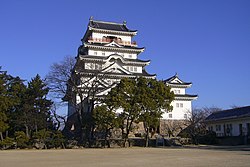Fukuyama Castle
You can help expand this article with text translated from the corresponding article in Japanese. (November 2021) Click [show] for important translation instructions.
|
| Fukuyama Castle 福山城 | |
|---|---|
| Fukuyama, Japan | |
 Fukuyama Castle tenshu
 | |
| Type | Japanese castle |
| Height | (five stories) |
| Site information | |
| Controlled by | Mizuno clan (1622-1700), Matsudaira Tadamasa (1700-1710), Abe clan (1710-1874), Japan (1874-present) |
| Condition | Reconstructed, serves as history museum |
| Site history | |
| Built | 1619-1622, rebuilt 1966 |
| Built by | Mizuno Katsunari |
| In use | 1622-1874 |
| Materials | stone, wood, plaster walls (original); concrete, steel, wood, stone, plaster (reconstruction) |
| Demolished | 8 August 1945 |
Fukuyama Castle (福山城, Fukuyama-jō), sometimes called Hisamatsu Castle (久松城, Hisamatsu-jō) or Iyō Castle (葦陽城, Iyō-jō) was the
Overview
Fukuyama Castle is located at a hill in the center of Fukuyama city. Prior to the
The new Fukuyama Castle occupied a hill with a length of 400 meters and width of 200 meters. The inner bailey occupies the southern half of the hill, and contains a five-story tenshu at its northern edge. The southern edge was protected by two yagura turrets.The Fushimi yagura was a white three-story structure transferred from abolished Fushimi Castle in Kyoto. The Tsukumi yagura has a red handrail balcony. Between these two yagura is the main gate of the castle, also transferred from Fushimi Castle.
The secondary bailey occupied the north half of the hill, and outer bailey surrounded south half of the hill. Fukuyama Castle had seven three-story yagura and 15 smaller yagura, and tall stone walls, and was surrounded by water moats, connected by canal to the Seto Inland Sea. [1]
The
Current situation
After the Meiji Restoration, most of the buildings except for the tenshu and a number of yagura were demolished. The castle grounds became a public park. In 1931, the tenshu was designed a "National Treasure" under the former Cultural Properties Protection Law. However, the tenshu burned down during World War II. Much of outer areas of the castle grounds disappeared due to the construction of railways and urban development.[6] Fukuyama Station was built directly adjacent to the inner bailey of the castle and the tenshu can be seen clearly from its platforms.
In 1947, the Fukuyama Industrial Exposition is held at the ruins of Fukuyama Castle. In 1950, the surviving Fushimi Yagura and Sugitetsu Gomon were designated National Important Cultural Properties.[7] [8] The tenshu was rebuilt in 1966 along with the Tsukumi yagura.[1] In 1973, the Kagami yagura was reconstructed, and the bell tower in 1979. The Fukushima Museum of Art opened on the site of the west outer moat in 1988 and the Hiroshima Prefectural Museum of History on the ruins of the Sannomaru enclosure in 1989.[3]
Gallery
-
Tenshu
-
Tenshu, seen from the side.
-
Panorama of the castle in 1873.
-
Fushimi Yagura (ICP) in 1934.
-
Sujigane Gate (ICP)
-
Bathhouse (Yudono).
-
Kane Yagura.
-
Inner Bailey
See also
References
- ^ ISBN 978-4805313879.
- ^ "福山城跡". Cultural Heritage Online (in Japanese). Agency for Cultural Affairs. Retrieved 25 December 2022.
- ^ ISBN 4311750404.(in Japanese)
- ^ "Fukuyama Castle". JCastle. Retrieved 6 September 2018.
- ^ "Fukuyama Castle". Japan Travel. 2018. Retrieved 6 September 2018.
- ISBN 978-4805313879.
- ^ "福山城伏見櫓". Cultural Heritage Online (in Japanese). Agency for Cultural Affairs. Retrieved 25 December 2022.
- ^ "福山城伏筋鉄御門". Cultural Heritage Online (in Japanese). Agency for Cultural Affairs. Retrieved 25 December 2022.
Literature
- Benesch, Oleg and Ran Zwigenberg (2019). Japan's Castles: Citadels of Modernity in War and Peace. Cambridge: Cambridge University Press. p. 374. ISBN 9781108481946.
- De Lange, William (2021). An Encyclopedia of Japanese Castles. Groningen: Toyo Press. pp. 600 pages. ISBN 978-9492722300.
- Schmorleitz, Morton S. (1974). Castles in Japan. Tokyo: Charles E. Tuttle Co. ISBN 0-8048-1102-4.
External links
 Media related to Fukuyama Castle at Wikimedia Commons
Media related to Fukuyama Castle at Wikimedia Commons- Fukuyama Castle Museum









